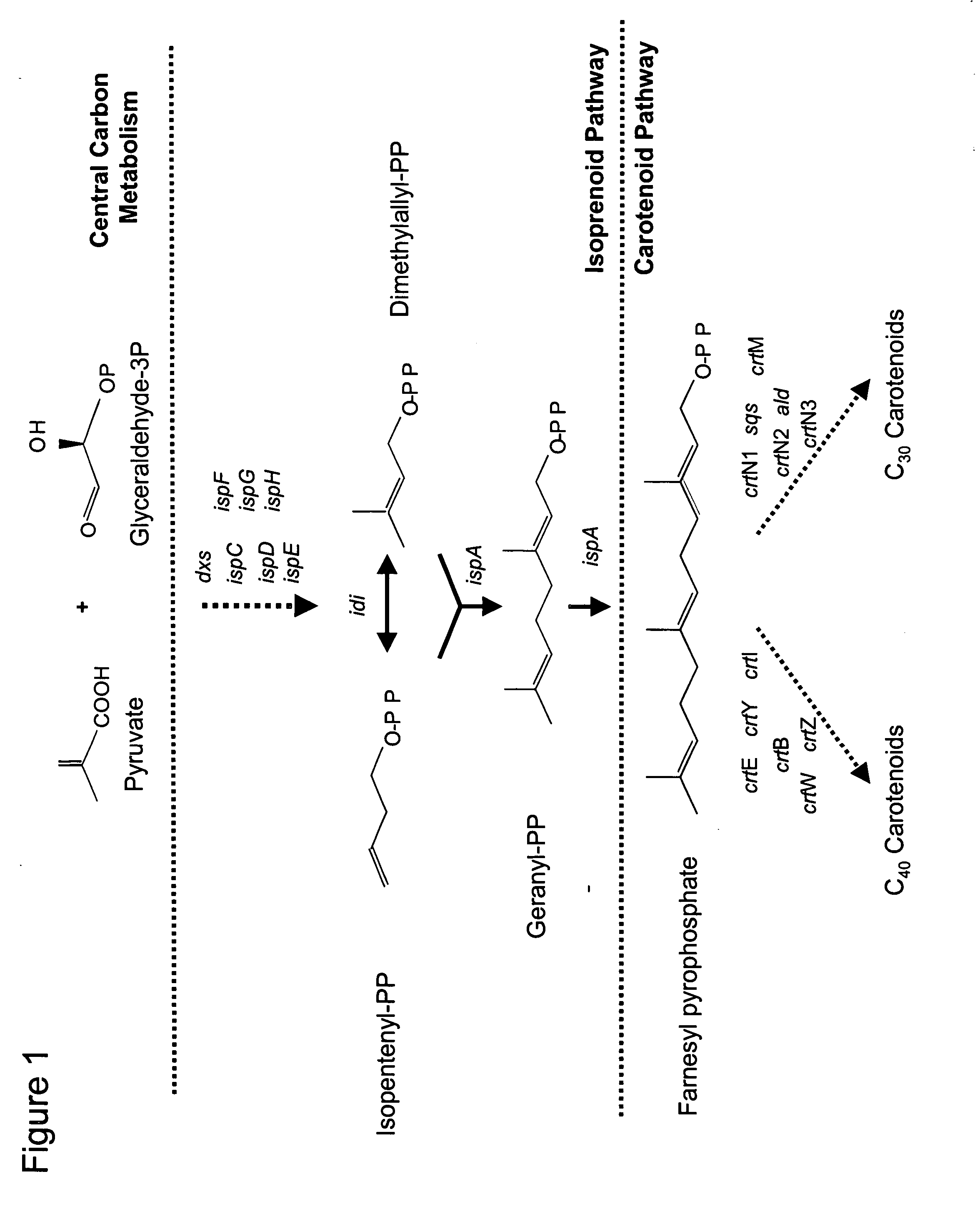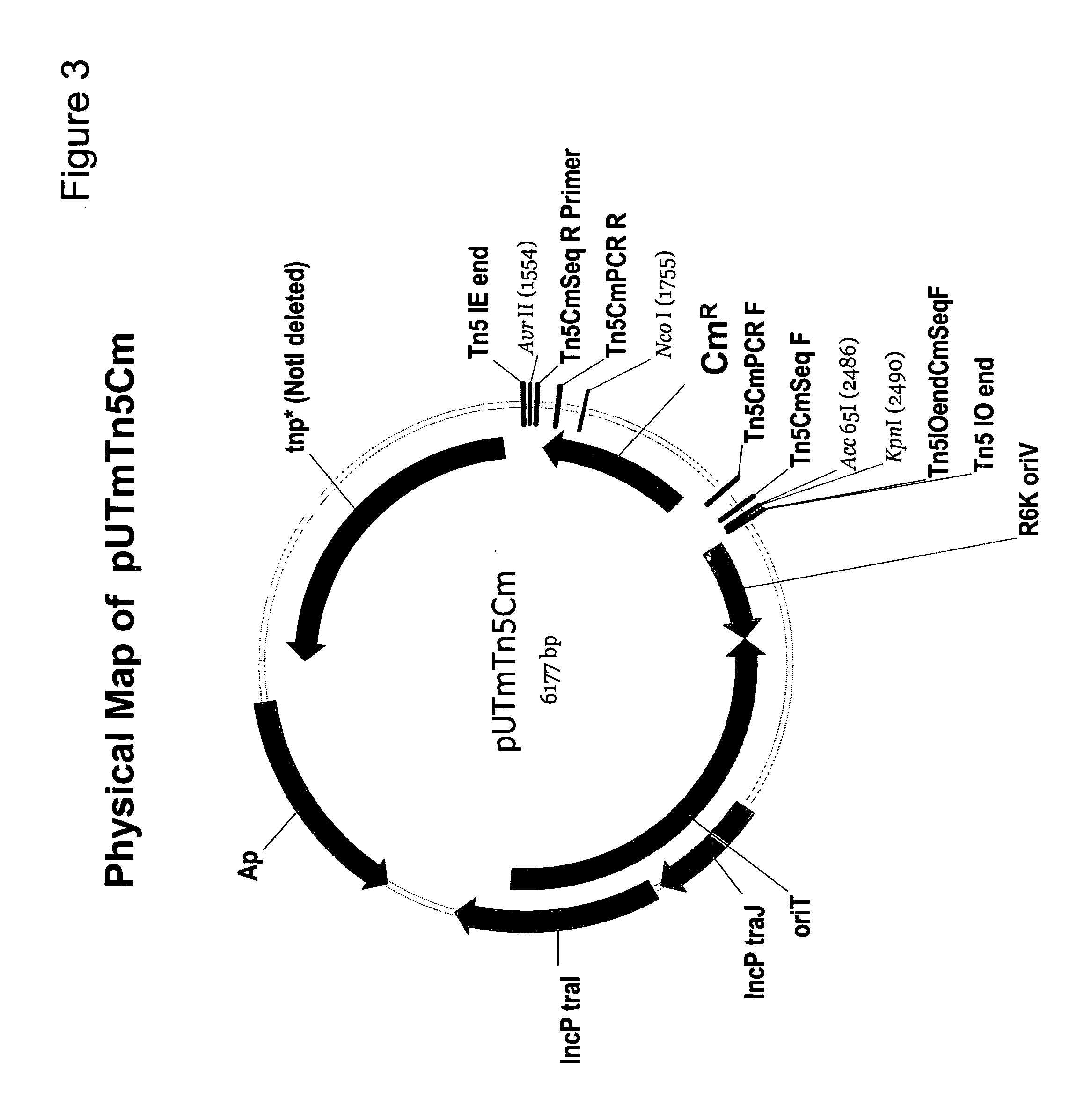Process for chromosomal expression of foreign genes in the fliC region of a methylotrophic microbial host cell
a technology of methylotrophic microbial host cells and foreign genes, which is applied in the field of bacterial gene expression and metabolic engineering, can solve the problems of challenging and time-consuming engineering changes such as adding, removing or modifying genetic elements, and reducing the growth rate of the host cell, so as to achieve high level of expression
- Summary
- Abstract
- Description
- Claims
- Application Information
AI Technical Summary
Benefits of technology
Problems solved by technology
Method used
Image
Examples
example 1
Construction of Promoterless Carotenoid Transposons
[0188] Promoterless carotenoid transposons were constructed for the purpose of identifying chromosomal insertions site that support high-level carotenoid gene expression and stable carotenoid production.
[0189] The in vivo transposition vector pUTminiTn5gfpTet provided essential plasmid and transposon functions used to construct a promoterless carotenoid transposon vector. The carotenoid genes necessary for canthaxanthin or astaxanthin production were taken from carotenoid plasmids pDCQ334 (SEQ ID NO: 1), pDCQ341 (SEQ ID NO: 2), pDCQ343 (SEQ ID NO: 3), or pDCQ377 (SEQ ID NO: 4). In addition, the kanamycin resistance gene (KnR) was PCR amplified from EZ::TN™ (Epicentre, Madison, Wis.).
Preparation of Several Carotenoid Gene Cluster Expression Plasmids
Plasmid pDCQ334 (Astaxanthin Gene Cluster)
[0190] Plasmid pDCQ334 (SEQ ID NO: 1) was created by cloning into the broad host range plasmid pBHR1 (MoBiTec GmbH, Goettingen, Germany) cod...
example 2
Growth Of Methylomonas Sp. 16A
[0212] Example 2 describes the standard conditions used for growth of Methylomonas sp. 16a (ATCC PTA-2402) and derivatives thereof, as described in U.S. Pat. No.6,689,601, hereby incorporated by reference.
Methylomonas Strain and Culture Media
[0213] The growth conditions described below were used throughout the following experimental Examples for treatment of Methylomonas sp., unless conditions were specifically described otherwise.
[0214] Briefly, Methylomonas sp. MWM1200 was typically grown in serum stoppered Wheaton bottles (Wheaton Scientific; Wheaton, Ill.) using a gas / liquid ratio of at least 8:1 (i.e., 20 mL or less of ammonium liquid “BTZ” growth medium in a Wheaton bottle of 160 mL total volume). The composition of the BTZ growth medium is given below. The standard gas phase for cultivation contained 25% methane in air, although methane concentrations can vary ranging from about 5-50% by volume of the culture headspace. These conditions compr...
example 3
Tri-Parental Conjugation of the Various Transposon Vectors into Methylomonas sp
[0218] The genetic procedure of in vivo transposition was used to screen the Methylomonas genome for chromosomal locations that will support high-level carotenoid expression. The first promoterless carotenoid transposon used was Tn334Kn. Several colonies were identified that exhibited a high level of total carotenoid production.
[0219] Each of the promoterless carotenoid transposon vectors were transferred into Methylomonas sp. MWM1200 via triparental conjugation. Specifically, the following were used as recipient, donor, and helper, respectively: Methylomonas sp. MWM1200, E. coli SY327 containing the promoterless carotenoid transposon vectors, and E. coli containing pRK2013 (ATCC No. 37159).
Theory of the Conjugation and In Vivo Transposition
[0220] The mobilization of vector DNA into Methylomonas occurs through conjugation (tri-parental mating)(see U.S. Ser. No. 10 / 997,308, U.S. Ser. No. 10 / 997,844, a...
PUM
| Property | Measurement | Unit |
|---|---|---|
| temperature | aaaaa | aaaaa |
| temperature | aaaaa | aaaaa |
| pH | aaaaa | aaaaa |
Abstract
Description
Claims
Application Information
 Login to View More
Login to View More - R&D
- Intellectual Property
- Life Sciences
- Materials
- Tech Scout
- Unparalleled Data Quality
- Higher Quality Content
- 60% Fewer Hallucinations
Browse by: Latest US Patents, China's latest patents, Technical Efficacy Thesaurus, Application Domain, Technology Topic, Popular Technical Reports.
© 2025 PatSnap. All rights reserved.Legal|Privacy policy|Modern Slavery Act Transparency Statement|Sitemap|About US| Contact US: help@patsnap.com



